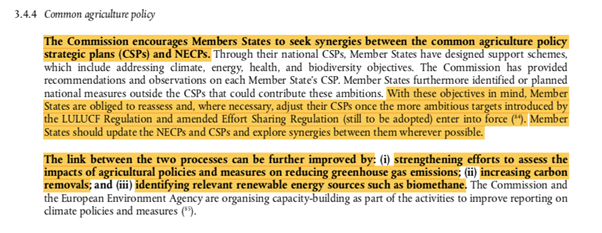
Although the CAP Strategic Plans have been approved and are now being implemented, they are not closed files. Once a year, amendments can be proposed by Member States and, under specific conditions, other adaptations can be required. Recent readjustments of targets for climate mitigation in different legislations to meet the ambition of the Fit For 55 package should offer an opportunity to raise the ambition of CAP Strategic Plans on climate action. In this article, we will consider how the CAP Strategic Plans might be amended and, under what circumstances, and assess the potential move forward that the progress on the Fit For 55 package can provide.
By Mathieu Willard
New targets for climate action
On March 28th, two revised regulations were adopted by the Council to enable the EU to reduce its net greenhouse gas (GHG) emissions by at least 55% by 2030 compared to 1990. The first is the Effort Sharing Regulation (ESR), setting up an EU-level GHG emission reduction target of 40% by 2030, compared to 2005, for concerned sectors. The second is the land use, land-use change and forestry (LULUCF) covering the use of soils, trees, plants, biomass and timber. It sets a new target of 310 Mt CO2 equivalent of net removals in that sector in 2030 and neutrality of the land sector by 2035.
As a result, Member States will need to revise their National Energy and Climate Plans (NECP) to include those new legally binding targets. This is expected by June 30th. The Commission also provided a guiding document for this revision, in which it is clear that the NECP will need to adapt to the new ESR and LULUCF targets.
Moreover, as shown in Figure 1 below, the guiding document indicates that Member States are “obliged to reassess and, where necessary, adjust their CAP Strategic Plans (CSPs) once the more ambitious targets introduced by the LULUCF Regulation and amended Effort Sharing Regulation (still to be adopted) enter into force”.

CSPs will thus need to be reassessed and “where necessary”, amended. Already this phrasing suggests that Member States will have the opportunity to circumvent adapting their CSPs, but what does the CSP regulation actually provide on this issue and amendments in general?

Amending the CAP
To understand the rules framing amendment opportunities in the CAP, we have to look at Article 119 and 120 of the CSP regulation, and the delegated regulation on procedures and time limits for submission of amendments by Member States.
Article 119 and the delegate regulation on amendments set up the rules for amending the CAP. Although some exceptions apply to specific CAP instruments, here are the main directives:
- Amendments must be justified by setting out their impact on the CAP-specific objectives.
- The Commission needs to approve or reject the proposed amendments and can provide observations within 30 working days from the submission.
- The Commission has 3 months to assess the submission.
- Each Member State can make one submission (containing one or more amendments) per calendar year. Three additional submissions can be made during the duration of the whole CSP period. No deadline for submissions is mentioned.
- Interventions under Rural Development can be amended at any time without restrictions in number if they do not impact result indicator targets.
- Editorial changes are exempted from the procedure.
- Necessary changes due to natural disasters and catastrophic events are not restricted in number.
- Any amendment proposal of the CSP must be examined by the monitoring committee.
As it is related to the topic of this article, it is important to note that submissions pursuant to article 120 do not count for the limitation of submissions per year.
Article 120 lays down the rules applying when an EU legislation concerning the environment and climate, to whose objectives Member States’ CSPs should contribute to and be consistent with, has been modified.

The text provides similar explanations as the NECP guiding document, adding that, in the case of regulations, Member States have up to 6 months to provide their assessment. To see if the rule effectively applies to the new LULUCF, ESR and subsequent NECP targets, we have to check annexe XIII. In there, we indeed find that Regulation 2018/841 (LULUCF), Regulation 2018/842 (ESR) and Regulation 2018/1999 (NECP) are all included.
Additionally, and for future pressuring efforts on environment and climate action, it is important to note and not forget that other essential pieces of legislations are included in annexe XIII. Amongst them, we find legislation concerning water quality, conservation of natural habitats, nitrate pollution from the agricultural sector, air quality, promotion of renewable energies and sustainable use of pesticides.

What can we expect?
In terms of timelines, the amended LULUCF and ESR targets are foreseen to be published in the Official Journal in June. The starting date should then be the 1st of July. From then, Member States have 6 months to assess the impact on their CSP, bringing us to the end of December. In addition, Member States can make use of their once-per-year amendment opportunity.
If Member States conclude that an adjustment is needed to keep up with the new targets and propose an amendment, perfect. But, when looking back at the whole approval process of the CSPs, it is clear that that scenario is unlikely.
In the case where a Member State would propose a poor justification for not amending their CSP accordingly to the higher ambition of new binding targets, it is unclear what the Commission could actually do to enforce an adjustment of the plan as there is no legal basis to do so. Although the Commission could pressure Member States to adapt their plans, the failure of the Observation Letters having low impact on the approval process of the CSPs shows that the fight must take place on national level.

On a national level, it is more likely that pressure from civil society organisations and farmer’s unions could force a State to act. When discussing amendments to be submitted, monitoring committees should be provided with more bargaining opportunities. But for that, stakeholders would need much better material on which they could base a pressuring campaign. Which brings us to the real limiting factor, besides the absence of legal instruments to enforce such improvements, that is coherent and thorough data sets as well as better indicators to enable real consistency checks on the CSPs.
Indicators R-12 to R-18 are used to assess the contributions of the CSPs to climate change mitigation. Those indicators are either based on “shares”: share of agricultural area under-supported commitments, share of farms under-supported commitments, share of livestock unit under-supported commitments; or based on budget allocated. But those do not really convey the impact which completely depends on the quality of the measures.
In terms of data, disaggregated data on interventions and beneficiaries will only be reported by Member States in 2025.
Only with good data sets and improved indicators can we efficiently move forward. Without those, it is easy for Member States to simply disguise bad results, or anticipated results. This might be where the CAP Networks could be useful, by concentrating on ways to display comparable data sets, with budgets and quality of interventions included.

Talking climate and agriculture requires tact
It is necessary to push for more climate ambition in the CAP Strategic Plans. It must be said that it is a point on which tact is required. The CAP is still primarily a tool for farmers and should in priority support the development of small-medium scale farming, agroecology, and attract young farmers.
Going back to Figure 1 and the NECP guiding book, we can directly see that the new climate targets can be used to propose solutions (e.g. Carbon Farming, Biofuels) that could put pressure on small-scale farming. Carbon Farming, when financed through voluntary carbon markets, or the development of biofuels, can both add pressure on land accessibility and prevent young farmers from finding appropriate land.
It’s important to hold focus on the primary goal of transition towards agroecology when discussing farming and the CAP, even when talking about climate change. As it is often said, agroecology cools the earth.
Download this article as a PDF
 This article is produced in cooperation with the
This article is produced in cooperation with the
Heinrich Böll Stiftung European Union.
More on CAP Strategic Plans
CAP post-2027: An Integrated Rural and Agricultural Policy – Part 2
CAP post-2027: An Integrated Rural and Agricultural Policy – Part 1
Can the CAP Strategic Plans Help in Reaching our Pesticide Reduction Goals?
Wallonia’s Observation Letter: A plan that fails to address climate and biodiversity crises
CAP Strategic Plans and Food Security: Fallow Lands, Feeds, and Transitioning the Livestock Industry
A Just and Green CAP and Trade Policy in and Beyond the EU – Part 2
A Just and Green CAP and Trade Policy in and Beyond the EU: Part 1
Bulgaria’s CAP Strategic Plan: Backsliding on Nature and Biodiversity
Changes “required” to Ireland’s CAP Strategic Plan – European Commission
French CAP Plan: What Opportunities for Change During the New 2022-27 Presidential Term?
CAP, Fairness and the Merits of a Unique Beneficiary Code – Matteo Metta on Ireland’s Draft Plan
ARC Launches New Report on CAP as Member States Submit Strategic Plans
Slashing Space for Nature? Ireland Backsliding on CAP basics
Quality Schemes – Who Benefits? Central America, Coffee and the EU
Civil Society Organisations Demand Open and Ambitious Approval of CAP Plans
CAP Strategic Plans: Germany Taking Steps in the Right Direction?
CAP Strategic Plans: Support to High-Nature-Value Farming in Bulgaria
Commission’s Recommendations to CAP Strategic Plans: Glitters or Gold?
German Environment Ministry Proposals For CAP Green Architecture
CAP Performance Monitoring and Evaluation Framework – EP Position
A Rural Proofed CAP post 2020? – Analysis of the European Parliament’s Position
CAP Beyond the EU: The Case of Honduran Banana Supply Chains
CAP | Parliament’s Political Groups Make Moves as Committee System Breaks Down
CAP & the Global South: National Strategic Plans – a Step Backwards?
CAP Strategic Plans on Climate, Environment – Ever Decreasing Circles
European Green Deal | Revving Up For CAP Reform, Or More Hot Air?
Climate and environmentally ambitious CAP Strategic Plans: Based on what exactly?
How Transparent and Inclusive is the Design Process of the National CAP Strategic Plans?





